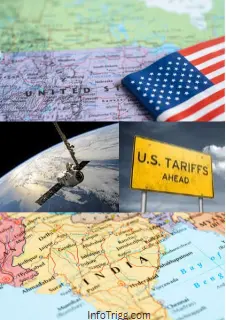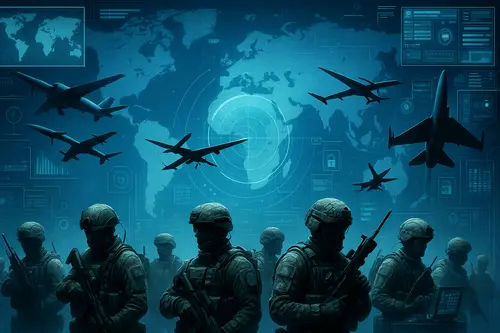
As India and the US has already deployed the NISAR, and will place Blue Bird soon, their economic relationship is beginning to fracture amid tariff increases and increasing geopolitical sanctions. This juxtaposition creates a new paradox at the heart of global diplomacy—scientific collaboration is flourishing in orbit, while economic orthodoxy is fraying below it.
India and the USA are pushing the envelope of space cooperation by jointly launching missions equipped with some of the most advanced Earth-observing technologies ever built. NASA-ISRO’s NISAR, and Blue Bird, a satellite developed by AST SpaceMobile in conjunction with ISRO and NASA, represent the zenith of technological collaboration and bilateral trust.
On the other hand, the US has imposed a 25% blanket tariff on Indian imports, in addition to an as of yet unidentified penalty the US will place on India for continuing its import of Russian crude oil. These actions threaten to unseat decades of trade gains between the two democracies and threaten the fabric of the economic partnership altogether.
This blog will consider how India and the US are cooperating in orbit but colliding on the ground, a duality that characterizes the complexity of modern strategic partnerships in a multipolar world.
US-India Space Cooperation
The US-India space partnership traces back to the 1960s and 1970s. India and the USA first collaborated on the 1975 Satellite Instructional Television Experiment (SITE), when NASA launched the ATS-6 satellite to broadcast educational programs to rural India. It was the first real venture into public interest technology diplomacy.
The Cold War years halted collaboration, but after 2005, particularly with the US-India Civil Nuclear Agreement, cooperation surged. With India’s growth as a space player and the US’s desire to counter China’s growth, a fertile collaboration of missions, information sharing and satellite launches emerged.
Blue Bird and NISAR Missions: Symbols of Trust in Space
In a world of increasing tensions, the India-US space co-operation relationship provides an inspiring counter-narrative of trust, innovation, and strategic alignment. Two major efforts, the Blue Bird and NISAR projects, exemplify this dynamic perfectly.
Blue Bird communication satellite
Blue Bird is a commercial communication satellite developed by U.S.-based AST SpaceMobile. Weighing approximately 6,000 kg, it features a large 64 m² phased-array antenna and is designed to deliver mobile broadband directly to smartphones from space. Developed with support from NASA and ISRO, the satellite will be launched aboard ISRO’s trusted Polar Satellite Launch Vehicle (PSLV).
Launch: Late 2025– According to ISRO Chair V. Narayanan, ISRO is making preparations to launch the Blue Bird Block‑2 communications satellite “within the next three to four months,” the first launch since NISAR’s successful launch
Importance:
- World’s first satellite-to-smartphone broadband network in space
- India is launching this U.S. satellite despite the ongoing 25% tariffs and Russia-linked penalty duties, making it a powerful symbol of sectoral resilience
- Demonstrates India’s growing space launch capabilities and commercial attractiveness
- The fact that ISRO will launch a U.S. private satellite heavier than NISAR underlines India’s strategic space clout
NASA-ISRO Synthetic Aperture Radar Mission(NISAR)
NISAR—the NASA-ISRO Synthetic Aperture Radar Mission—is the world’s first dual-frequency radar imaging satellite. NISAR was launched on 30th July 2025 on India’s GSLV Mk II and uses L-band (NASA) and S-band (ISRO) radar to track small variations on the Earth’s surface.
Mission
- Monitoring climate change.
- Mapping agriculture.
- Preparedness for disasters (earthquakes, landslides, floods).
- Tracking ecosystems.
Strategic Importance of Space Missions
For India :
- Strategic Autonomy: Enhances self-reliance in space and defense tech (ex: Chandrayaan, Gaganyaan).
- National Security: Supports missile defense, border surveillance, and communication.
- Disaster & Agriculture Monitoring: Satellites like NISAR help in managing floods, droughts, crop yields.
- Economic Opportunity: Opens commercial launch services (PSLV), space startups, jobs.
- Geopolitical Standing: Space success boosts India’s global image and diplomatic leverage.
- Energy & Climate Planning: Space data aids in renewable mapping, urban planning, and climate action.
For United States :
- Global Space Dominance: Maintains leadership in space technology and exploration.
- Dual-use Tech Edge: Civilian innovations often fuel defense and commercial sectors.
- Allied Dependence Reduction: Strategic missions with partners like India strengthen multipolar alliances.
- Climate Intelligence: NISAR contributes to global climate research leadership.
- Telecom & Commerce Expansion: Blue Bird supports US-based commercial telecom ventures (AST SpaceMobile).
- Countering Adversaries: Ensures resilience against growing space competition from China and Russia.
While trade disputes are occurring on the ground, these satellites are building trust in space. Blue Bird and NISAR represent the shared commitment to innovation, climate resilience, and accessibility of digital information. These values extend beyond our bureaucracies and politics.
Geopolitical Implications: Countering China’s Space Race
As China rapidly expands its space footprint—with the Tiangong space station, BeiDou navigation system, and lunar ambitions—India and the US are aligning to create a democratic counterbalance in space.
Blue Bird may provide strategic communication coverage to reinforce regional surveillance and connectivity.
Quad Space Working Group (US, India, Japan, Australia) reflects growing space diplomacy.
NISAR’s Earth-monitoring can help track China’s activities in the Indo-Pacific, South China Sea, and Himalayas.
U.S. Trade Pressure & India’s Strategic Autonomy

Tariffs on Indian Exports- On July 30, 2025, U.S. President Trump announced a nation-wide 25% tariff on all goods entering the United States from India, effective at midnight on August 1, 2025. This new tariff process replaced a previously suspended reciprocal 26% tariff announced in April; effectively, the fully tariff regime establishes a baseline 10% tariff that continues to exist as a floor beneath the new 25% tariff.
Impact on Key Export Sectors
Indian Exports to the U.S. were nearly USD 128 billion in 2024, with the U.S. being India’s largest destination for exports. India was in trade surplus with U.S. this year.
The impacted sectors include textiles and apparel, pharmaceuticals, automobiles and parts, electronics/semiconductors, gems and jewellery, marine products, steel and aluminum, and agro-products, which all now face 25% levies.
Some sectors—such as pharmaceuticals, critical minerals, and semiconductors—have received temporary exemptions during their ongoing negotiations
Leaders in Indian industry warn of loss of competitiveness, possible loss of market share to competitors such as Vietnam and Bangladesh, and increased pressure on labor-intensive exports and MSMEs
As a reaction, India doubles down on Swadeshi and Make in Indian initiatives, encourages promotion of homegrown brands, pushes export diversification to ASEAN and the EU, and is looking into its options under the WTO to protect our exporters and our national interests.
Penalty on Russian Oil & Defence imports
The announced penalty tariff is directly connected to the crude oil and military equipment that India imports from Russia, and India is noted as one of Russia’s largest energy importers in addition to China
Economic Implications of U.S. Tariffs and Sanctions Threats
Indian Exporters Under Pressure
- Sectors most affected include textiles, generic pharmaceuticals, processed food, and auto parts.
- India’s $77 billion export basket to the U.S. (FY 2023–24) is at risk, particularly value-added goods that are price-sensitive in the U.S. market.
Competitor Countries Face Higher Tariffs
India fares better in comparison to some:
- China: 30% tariff
- Brazil: 50%
- Canada & Mexico: 25–35%
- This gives India a comparative cost advantage for mid-tech and service-sector exports, although Vietnam and Taiwan (20%) are catching up fast.
Geostrategic Pressure Points
- The U.S. recently pledged support for infrastructure development in Pakistan, India’s strategic adversary, as part of its China+1 balancing in South Asia.
- This comes at a time when India is being nudged away from the Russia-Iran energy nexus, leading to tensions in strategic autonomy.
Investor Confidence at Risk
- Multinationals in India—especially in the tech and defense sectors—worry about retaliatory tariffs or restricted market access.
- Some global firms are now exploring supply chain diversification to ASEAN nations if Indo-U.S. trade friction escalates.
While it is still unclear what specifics are entailed, legislation in the U.S. Congress, such as the Russia Sanctions Act 2025 would impose tariffs of 500% on countries that are importing Russian energy or arms, should Russia fail to engage in peace negotiations in Ukraine. Advisors noted that it is important for them to emphasize this is the first “secondary tariff” that has ever been applied by the U.S. as this represents an increase and importance of trade diplomacy.
What This Duality Points to in 21st Century Alliances
The juxtaposition between growing cooperation in the space domain (e.g., NISAR, BlueBird) and rising tensions in trade disputes (e.g., tariffs, sanctions) indicates a new reality which reflects the manner in which alliances are fracturing, and are being formed fluidly, on an issue-by-issue basis.
Trust in Space, Tensions on Terra Firma
When it comes to working in space, India and the USA can cooperate to build satellites, share important Earth-observing data, and collaborate to allow the power of space technologies to work for them in maintaining climate resilience. Simultaneously, the two partners are engaged in trade wars over oil imports, trade deficits, and tariffs, again showcasing how alliances rarely fit into a consistent ‘friend-or-foe’ paradigm.
Welcome to Issue-Based Alignments
The era of binary alliances, from the Cold War, is gone. Now geopolitics is driven by:
- Multi-alignment (Indian partnerships with both Russia & US)
- Transactional Diplomacy (schemes rooted in mutual self-interests, rather than principles or ideology)
- Compartmentalized cooperation (e.g., QUAD for Indo-Pacific region; BRICS for economic reform)
This duality allows India to:
- Pursue its strategic autonomy without anchoring itself to camps
- Realize the benefits to security, technology, and defence by cooperating with the USA while maintaining its energy and economic relations with Russia.
- Become the friend or partner that every country seeks, bridging the East and West using a variety of forums including G20, BRICS+, I2U2, and QUAD
India-US Relations UPSC relevance
This is a very hot topic for UPSC aspirants as it is multi-dimensional – like PSIR, International Relations, economics, prelims, Space research questions and many more. This makes this even more relevant for UPSC aspirants as in the UPSC pYQ, Space and satellite are continously making there way like question on Kessler syndrome. so, Multiple questions can be framed like-
UPSC Prelims (GS Paper I)
- Current Affairs: NISAR and Blue Bird missions are expected to appear as factual or concept-based questions.
- Science & Tech: Questions on radar technology, satellite types, dual-frequency use, PSLV launches.
- International Relations: Strategic cooperation questions focusing on Indo-U.S. partnerships.
Example Prelims-style Q:
“NISAR, jointly developed by India and the USA, is significant for which of the following purposes?”
a) Missile defense
b) Crop monitoring and climate study ✅
c) Deep space exploration
d) Artificial Intelligence
UPSC Mains (GS Paper II & III)
GS Paper II – International Relations
- India-U.S. Strategic Relations
- Space diplomacy as a tool of soft power and multipolar alliances
- Contrast with friction: tariffs, oil sanctions, Indo-Pacific divergence
GS Paper III – Science & Tech + Internal Security
- Technology Missions and Dual Use
- Climate science + strategic surveillance (dual-use nature of satellites)
- Indigenization of Technology
- Boost to ISRO’s commercial launch capability (e.g., Blue Bird on PSLV)
- Cybersecurity and Space as a Strategic Frontier
Essay Paper & Interview
- Themes like:
- “Cooperation in Space, Friction on Earth: A Tale of Modern Diplomacy”
- “Is Strategic Autonomy Possible in an Interconnected World?”
- “Technology as a Tool of Trust and Tension”
Conclusion: Can Space Cooperation Temper the Friction on Earth?
The present relationship between India and the United States is paradoxical in promise and pressure. Satellites such as NISAR and BlueBird offer symbols of mutual trust and high-end technology, as well as expansive global shared visions. On the other hand, tariffs in excess of 25%, penalty duties for crude demonstrations, and the targeting of adversaries geographically close to India reveal edges of sharper strategy and diplomacy.
But this isn’t dysfunction—this is the new diplomacy.
Space cooperation is never merely science; it is response focusing on long-term alignment. When two democracies trust each other in the use of orbital intelligence, environmental monitoring, and infrastructure in space, they provide a comprehensive baseline (ideologically speaking) more than an exchange of trade relations might offer.
The Very Big Question?
Will satellites in space cool the heat on Earth?
Perhaps not fully. But the sky can provide a higher ground; at least a diplomatically higher ground for geopolitical, cooperation, and strategic stability.
.

